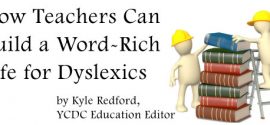Case Study – How Morningside Elementary School Helps Dyslexic Students Succeed

Teacher Training and a Well-Stocked Toolbox Help Dyslexic Students Succeed at One Atlanta Public School
Peek into a first grade classroom at Morningside Elementary School in Atlanta and there’s a good chance you’ll see students tapping out the sounds that comprise a word with their fingers or tossing bean bags in the air as they work to learn new words. In another classroom a group of third graders is decoding nonsense words while others sit in small groups engrossed in a discussion about a book they’re reading.
This is what reading instruction looks like at Morningside—and Audrey Sofianos, the school’s principal, couldn’t be prouder. “We provide a level of training that teachers never have. It just blows my mind. This is not what normal teachers are taught to do.”
Sofianos has good reason to boast. In September 2016 Morningside was named a National Blue Ribbon School by the U.S. Department of Education, in large part for an innovative literacy curriculum that includes an intensive focus on helping dyslexic students learn to read.
One sentence from Morningside’s application for the National Blue Ribbon designation neatly sums up this commitment: “We believe this cadre of teachers has the skills and tools needed to teach anyone to read no matter the challenge, and that is a powerful resource and component of our culture.”
Morningside, which has 889 students in grades K–5, is not a typical urban school. It has high student test scores and strong parental involvement, including a parent foundation that provides much of the funding for its extensive teacher training and innovative reading program. But the Morningside model demonstrates what is possible in a public school setting when administrators and teachers are determined to help all students, including those with dyslexia, reach their full potential.
Morningside’s literacy approach boils down to three key elements:
- A commitment to training teachers
- A well-stocked toolbox of options to meet the needs of every student
- A consistent approach to monitoring student progress
Teacher Training
Every teacher and administrator at Morningside is required to take a 70–hour training course called the Complete Reading Series (CRS), which covers early literacy, phonics, word roots and learning disabilities, including one component specifically on dyslexia. Because the course is broken down into a series of components, CRS can be learned by teachers over a few years without disrupting their classroom schedules.
CRS is designed to “empower teachers to possess, understand and master the content and instructional practices necessary to teach reading, spelling and comprehension to the gifted student, the general education student and to the student in need of remediation,” says Brenda Fitzgerald, executive director of the Georgia Educational Training Agency and creator of the program. In part, Fitzgerald based the course on research by the National Reading Panel, The Florida Center for Reading Research, the National Institute for Literacy and the work of Drs. Sally and Bennett Shaywitz of the Yale Center for Dyslexia & Creativity.
CRS was originally brought to Morningside during the 2011–12 school year by then-principal Rebecca Pruitt, who felt more needed to be done to keep students with dyslexia and other learning disabilities from leaving the school to receive more specialized instruction at private schools in the area, particularly The Schenck School, which specializes in educating dyslexic children. “When I moved to Morningside as their principal, I distinctly remember a family telling me they were leaving the school to go to Schenck, and I thought, ‘I want [my school] to have what they have. Why are people leaving? Who is going to take care of the kids who can’t afford that tuition? What is it that schools like Schenck have, and why can’t we do it here?’”
Pruitt made CRS a cornerstone of her efforts to retain such students. “CRS helps you start to peel back the layers of the onion” to reveal where students need extra help, says Pruitt. “Then it moves to programming for reading and for writing, and standardizing vocabulary, and looking at really understanding what work is needed to support our children.”
Today, 53 current Morningside teachers and administrators have completed or are in the process of completing CRS, which includes a day-long course on dyslexia given to the entire staff. Of those, 28 also have taken an intensive two-week training course in the Orton-Gillingham (OG) method, which uses visual, auditory and kinesthetic approaches to teaching reading and can be highly effective for dyslexic readers. Another 18 teachers and staff are scheduled to receive OG training over the next two summers.
“We consider this type of reading training and dyslexia-focused work a huge hallmark of our school,” said Sofianos, adding that the goal is for 100 percent of teachers and staff, including herself, to receive the OG training. “Our teachers have a lot of knowledge in how reading is taught and developmentally what should be happening along the way. That makes it much easier to identify whether a student is dyslexic or not.”
A Well-stocked Toolbox
Teachers at Morningside never rely on just one program or textbook. “We have multiple tools in our toolbox, so if one method isn’t working for a student we can always try a different approach until we get it right,” said Laurie Luckmann, a first grade teacher.
In addition to CRS and OG, those tools include Wilson Fundations Phonics, a research-based program that incorporates OG methods for teaching phonics and spelling in grades K–3. Each Fundations lesson focuses on carefully sequenced skills, including alphabet awareness, phonological awareness, phonemic awareness, decoding, vocabulary, fluency and spelling. It is designed to help teachers quickly identify and address reading, spelling and writing challenges.
Another critical tool in the toolbox is a reading manual created by the school to ensure all teachers understand and adopt Morningside’s balanced literacy approach, which progresses from phonemic awareness to phonics; decoding and fluency to reading comprehension; and vocabulary building through word study.
With this wide range of tools at their disposal, teachers have the flexibility to adapt quickly to students’ individual needs. For instance, Luckmann says that when her students are learning to read a non-phonetic word like “said,” some will “just know it after it’s repeated five or six times while others may need to write it 15 or 20 times in shaving cream before they get it” or toss a bean bag as they say the word.
These strategies are common at schools for students with learning disabilities, but extremely rare in mainstream public schools. “We use a very sensory approach for some kids such as tapping and clapping to help them sound out words and make the connection physically,” says Amelia Morel, an Early Intervention Program reading teacher for third and fourth graders.
Morel knows firsthand how unusual it is for public school teachers to understand and embrace such techniques. She spotted red flags in her own son’s reading that eventually led to a dyslexia diagnosis even though teachers at his school insisted he was “doing just fine.” Morel doesn’t blame the teachers but notes that they “simply don’t have the training” to recognize such problems.
Because all Morningside teachers receive the same training and tools, they also can more readily help each other when they aren’t sure what approach to take for a student. “I run things by Laurie (Luckmann) a lot to see if what I’m doing makes sense,” says Morel.
Monitoring Progress
Consistent training and use of the reading manual and Fundations means all teachers know what normal progress looks like and can immediately spot problems when a student is struggling to read. Three kids in Luckmann’s class of 20 students have been diagnosed with dyslexia, and 20 percent of students in grades three, four and five are receiving remedial reading services, most of whom are likely dyslexic, according to Morel. (As in many states, Georgia law prohibits schools from specifically identifying kids as having dyslexia.)
These students are monitored every week to check their progress. For instance, Morel’s third and fourth graders receive weekly nonsense-word fluency tests that align with whatever phonics they’re working on. To show mastery in a particular area, such as closed-syllable words with a vowel-consonant-consonant-vowel pattern, the students need to be able to read 10 nonsense words that follow that pattern in a minute or less. “Many couldn’t do it initially, but by the end of the unit all were getting at least eight to ten words right. This shows us that they have mastered that phonics piece” and are progressing toward greater fluency, says Morel.
Part of the strength of Morningside’s approach is that it benefits all students, not just those who are dyslexic. “I know every kid who goes through the first grade program is rock solid with this stuff and comes out with incredible phonics skills. It’s what all kids need,” says Luckmann.
Since adopting the program, student achievement overall has increased significantly at Morningside. Scores on Georgia’s Criterion-Referenced Competency Tests (CRCT) rose from 77 percent of the students exceeding in reading in 2012 to 90 percent in 2014. (This is the latest data available; the test used by the state changed in 2015.)
Challenges
Morningside’s successful literacy program stems from a deep commitment by its leaders, starting with former principal Pruitt and continuing now with Sofianos. But it also helps significantly that the school has the financial resources to match that commitment. Funding for the program, including the training courses and Fundations, comes solely from the school’s parent foundation. And none of it is cheap. The 10-day OG training, for instance, costs $1,100 per teacher, and the 12-day CRS course, typically taken over a two-year period, is $980 a head.
Sofianos readily admits that the school could not pay for any of this without parent support. “The funds we get from the district to develop teachers are the same funds we get to buy paper, scissors and pens,” she says, adding that the parents are “very proud to have well-trained teachers and happy to support the program.”
For schools without such support, adopting similar programs may seem prohibitive. For its part, Atlanta Public Schools is working to replicate elements of the Morningside approach district-wide, including recently purchasing Fundations for schools throughout the district.
Morningside teachers believe the type of training they’ve been lucky enough to receive should be standard practice in every school. Says Luckmann, “What makes me feel so good about coming to work every day is that I know what I’m doing for dyslexic kids will help all my kids. There is no doubt in my mind.”
Related
Dyslexia and Civil Rights: Making Room on the Bus for All Children
My early experiences have become my bridge to understanding dyslexia and the plight of students whose strengths go unnoticed in the classroom.
Read More
Building a word-rich life for Dyslexics
A confession: I get a significant thrill from reading research that confirms my personal suspicions.
Read More
How speech-to-text transformed a student’s 5th grade year
Last fall, the fifth graders in my class were the lucky recipients of iPads–one for each student.
Read More
Rand Center: A Commitment to Accommodations
“Dyslexia robs a person of time; accommodations return it.” Dr. Sally Shaywitz
Read More